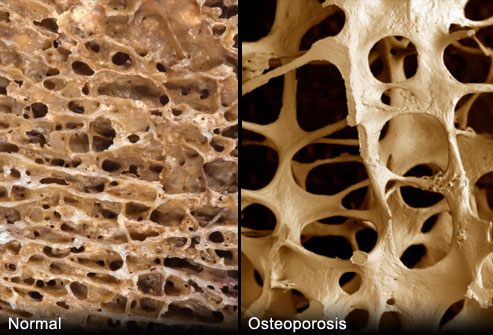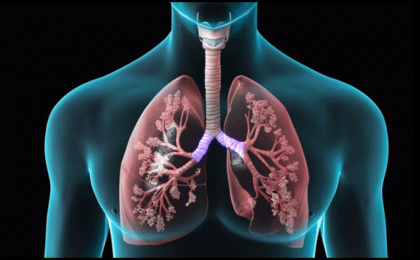What is osteoporosis?
- Its name comes from Latin for “porous bones.” Osteoporosis is a bone disease that develops when the body’s bone mineral density and bone mass decreases, or when the quality or structure of bone changes occurs.
- The microstructure of a healthy bone has small spaces, like a honeycomb. It increases the size of these spaces, leading the bone to lose strength and density.
- It can occur in people of any age, but it’s more common in older adults, especially women.
- In addition, to osteoporosis, there is high risk of fractures, or bone breaks, while doing routine activities such as standing or walking.
- The most common injuries in people with osteoporosis are:
- Broken wrist
- Broken hip
- Broken spinal bones (vertebrae)
- However, breaks can also happen in other bones, such as in the arm or pelvis.
- Sometimes a cough or sneeze can cause a broken rib or the partial collapse of one of the bones of the spine.
- This condition is not usually painful until a bone is broken, but broken bones in the spine are a common cause of long-term pain.


What are the Causes or Factor of Osteoporosis?
Causes/Factors that may increase your risk for osteoporosis include:
| 1. | Sex | : | Osteoporosis is more chance in a woman. Women have lower peak bone mass in body and smaller bones compare to men. |
| 2. | Age | : | As you age, bone loss growth and strength. Additionally, hormone level which useful in bone growth also lower at some age. |
| 3. | Body size | : | Slender, thin-boned women and men are at greater risk for osteoporosis as they have less bone to lose compared to larger boned body. |
| 4. | Race | : | White and Asian women are at highest risk. |
| 5. | Family history | : | Genetic structure may affect the bone structure which may leads to Osteoporosis. |
| 6. | Changes to hormones | : | Low levels of certain hormones can increase your chances of developing osteoporosis. For example: Low estrogen levels in women after menopause.Low levels of estrogen from the abnormal absence of menstrual periods in premenopausal women due to hormone disorders or extreme levels of physical activity.Low levels of testosterone in men. Overactive thyroid gland and Parathyroid gland. |
| 7. | Diet | : | Having diet with low in calcium and vitamin D can increase your risk for osteoporosis and fractures. Overeating or poor protein intake may have higher for bone loss and osteoporosis. |
| 8. | Other medical conditions | : | Endocrine and hormonal diseases, gastrointestinal diseases, rheumatoid arthritis, certain types of cancer, HIV/AIDS, and anorexia nervosa may leads to Osteoporosis. |
| 9. | Medications | : | Long Term use of below drugs, Glucocorticoids and adrenocorticotropic hormone. Antiepileptic medicines, which treat seizures and other neurological disorders. Cancer medications, which use hormones to treat breast and prostate cancer. Proton pump inhibitors, which lower stomach acid. Selective serotonin reuptake inhibitors, which are used for depression and anxiety. Thiazolidinediones, which treat type II diabetes. |
| 10. | Lifestyle | : | DrinkingLow level physical activity.Smoking Diet imbalanceLow body mass index (BMI) |
Diagnosis of Osteoporosis
- Diagnosing osteoporosis and osteopenia:
- Bone density scan (DEXA scan)
Osteoporosis Available Medications
| Sr. No. | Class of Medication | Mode of Action | Name of Drug/Brand |
| 1. | Bisphosphonates | Used to prevent the loss of bone mass | Alendronate Ibandronate Risedronate Zoledronic acid |
| 2. | Testosterone | Increase bone density | Testosterone |
| 3. | Estrogen and hormone therapy | Increase bone density after menopause in women. But may have risk of blood clot, heart disease and Cancer | Estrogen and/or combined progestin |
| 4. | Biologics | Reduce bone loss | Denosumab |
| 5. | Anabolic agents (Sclerostin inhibitor) | The product both enables new bone formation and decreases the breakdown of bone. | Romososumab |
| 6. | Raloxifene | treatment and prevention of osteoporosis in postmenopausal women (benefits of estrogen without many) | Raloxifene (Evista) |
| 7. | Calcitonin salmon | Used as nasal spray that reduces bone reabsorption | Fortical Miacalcin |
| 8. | Teriparatide | Stimulates bone growth | Forteo |
| 9. | Vitamin D | Vitamin D improves the body’s ability to absorb calcium and improves bone health Daily requirement: Minimum 600 international units (IU) of vitamin D per day. 800 international units (IU) of vitamin D per day ideal for above 70 ages. | Vitamin D in food: Cod liver oil, Trout and salmon. Many types of milk Cereal |
Natural Treatments
Try to have some supplements, such as red clover, soy, and black cohosh, may be used to help promote bone health.
Difference between Osteopenia vs osteoporosis vs Rheumatoid arthritis?
| Osteopenia | Osteoporosis | Rheumatoid arthritis (RA) |
| With osteopenia, your bones aren’t as dense as normal, but they’re not as weakened as they are if you have osteoporosis | Osteoporosis is a bone disease that progresses when bone mineral density and bone mass decreases, or when the quality or structure of bone changes. | In rheumatoid arthritis (RA), the body’s immune system attacks body’s own tissue & joints. In extremal cases, it attacks body internal organs also. Rheumatoid arthritis affects joint linings, causing painful swelling. |
| Osteopenia may lead to osteoporosis | May cause fracture and other difficulty. | May cause bone erosion ( It is a peri-inflammatory destructive bone lesion) or destruction and joint deformity. |
Why women are more susceptible to Osteoporosis?
- Hormone changes that happen at the menopause directly affect bone density. Estrogen protects your bones from losing calcium. Without enough estrogen, women could lose as much as a quarter of your bone mass in the first 10 years of menopause as per study.
- A hysterectomy (removal of the womb) before the age of 45, particularly when the ovaries are also removed may leads to this condition.
- Women’s bones are smaller and lighter
- Pregnancy may take your bones of minerals
- Women generally lives more than a avg. men life spam.
- Food supplements, eating capacity and life style not proper than men.
Read More:
Reference:
https://www.bones.nih.gov/health-info/bone/osteoporosis/overview
https://www.healthline.com/health/osteoporosis



